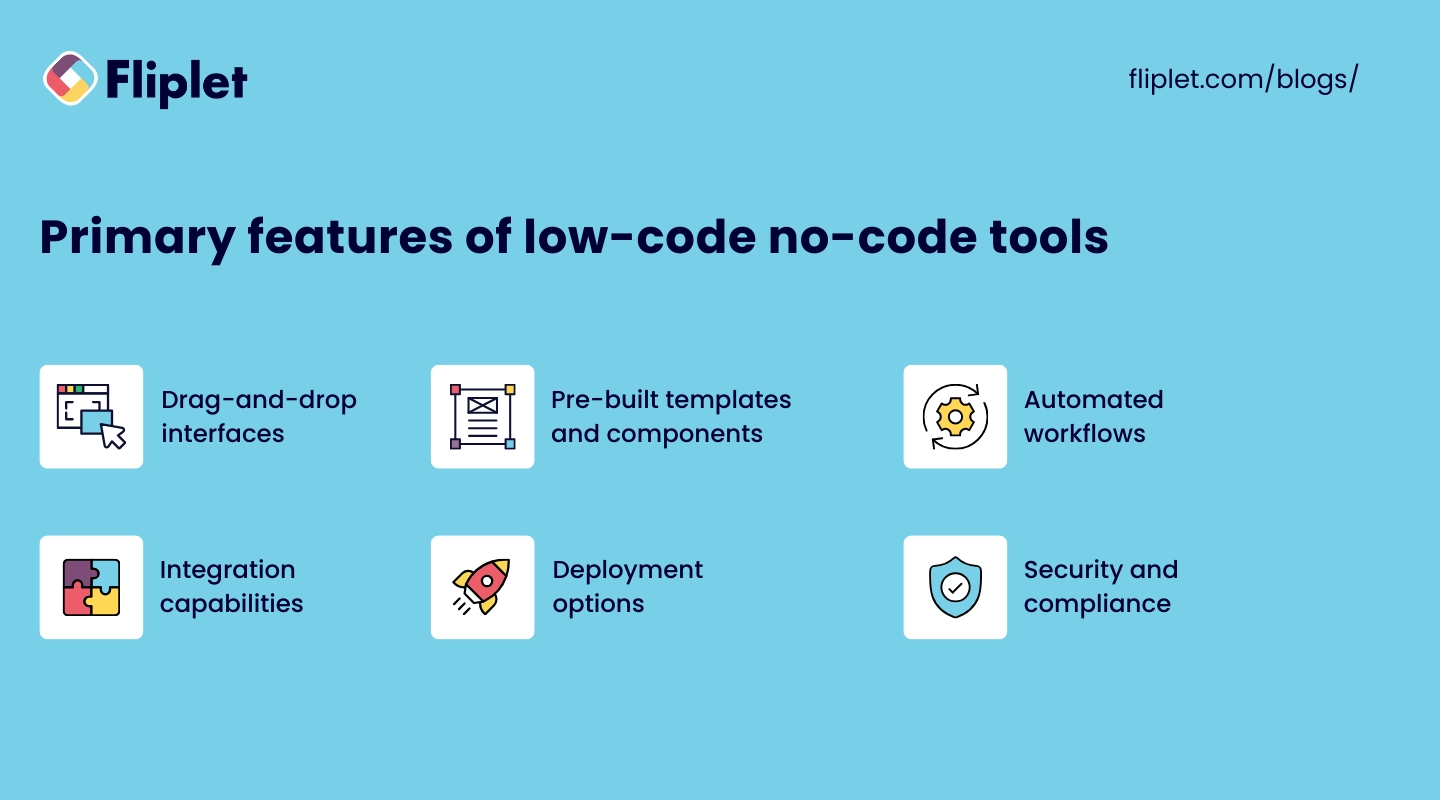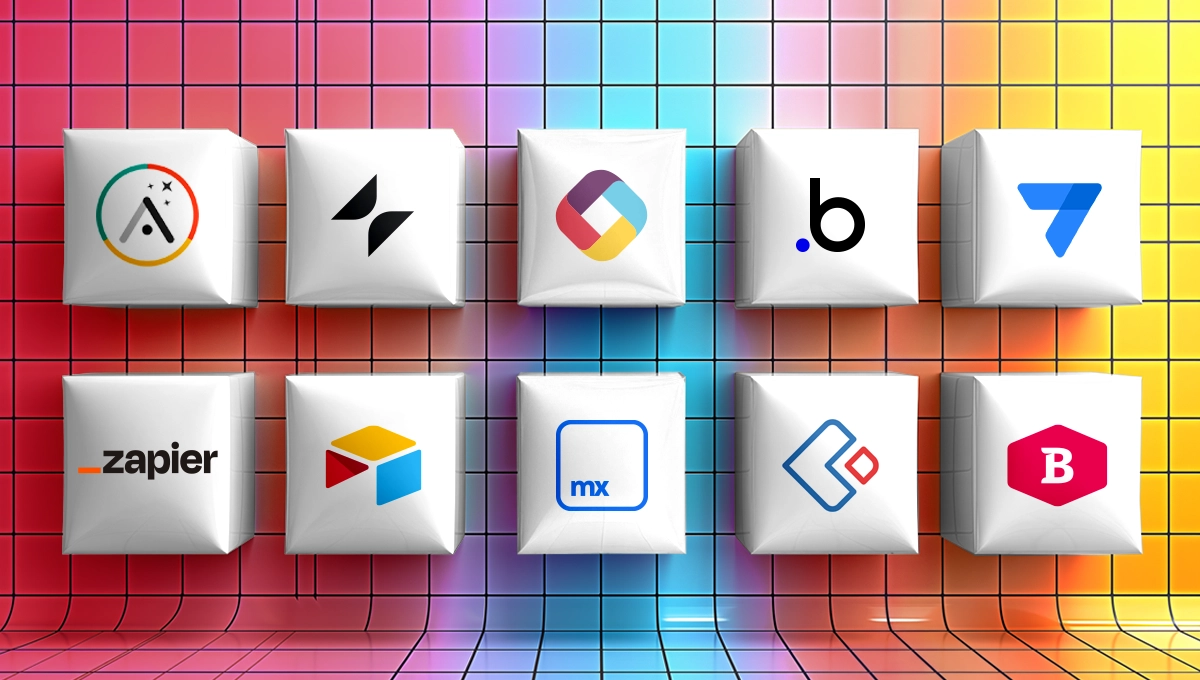What is low-code/no-code development? Guide and Best Platforms

Lisa Broom | Head of Marketing

In this comprehensive guide, you’ll learn everything about low-code/no-code development (LCNC). We’ll cover the definition of LCNC, explore various low-code/no-code platforms, and discuss the tools and solutions available. You’ll find practical examples of how these platforms are used and gain insight into the benefits they offer.
Whether you’re a developer looking to streamline your workflow or a business leader seeking efficient solutions, this guide will help you understand the landscape of low-code/no-code development and how to leverage it for your projects. By the end, you’ll have a clear understanding of how LCNC can transform your approach to app development, making it faster, more accessible, and more cost-effective.
What is low code no code development? (LCNC)
Low code no code development (LCNC) is an innovative approach to software creation that minimizes or eliminates the need for traditional coding.
- Low code platforms provide a graphical interface with drag-and-drop components, allowing users to build applications with minimal coding. This means that even those with basic technical knowledge can create functional applications.
- No code platforms go a step further, enabling users to create applications entirely through visual tools without any coding. This approach democratizes app development, making it accessible to non-technical users and accelerating the development process for experienced developers.
LCNC empowers businesses to quickly adapt to changing market demands, reduces the time and cost associated with traditional development, and fosters innovation by enabling a broader range of people to contribute to software creation.
What are low code no code platforms?
Low code no code platforms are software environments that provide the tools and frameworks necessary for LCNC development. These platforms offer a range of features including visual development interfaces, pre-built templates, integration capabilities, and automated workflows.
They are designed to simplify and speed up the application development process, making it possible to build and deploy applications much faster than with traditional coding methods.
Some of the best low code no code platforms include Fliplet, OutSystems, Mendix, and Appian. These platforms cater to various development needs, from simple business process automation to complex enterprise applications. By leveraging these platforms, organizations can enhance productivity, reduce reliance on highly skilled developers, and enable rapid innovation.
Whether you’re looking to automate routine tasks, develop customer-facing apps, or create complex enterprise solutions, low code no code platforms offer the flexibility and efficiency needed to meet your goals.
Low code vs no code

Understanding the difference between low code and no code is crucial for selecting the right approach for your project. Both methodologies aim to simplify and accelerate the application development process, but they do so in distinct ways and are suited for different types of users and applications.
Low code development platforms are designed to reduce the amount of hand-coding required to build applications. They provide a graphical interface with drag-and-drop components, pre-built templates, and automated workflows that streamline the development process. However, low code platforms still allow for some level of coding, which means that developers can customize and extend applications beyond the built-in features. This flexibility makes low code platforms ideal for building complex applications that require a high degree of customization and integration with existing systems.
Low code platforms are typically used by both professional developers and tech-savvy business users. Developers appreciate the efficiency gains and the ability to focus on more complex, high-value tasks, while business users can participate in the development process without needing extensive coding knowledge.
Takeaway: Low code platforms are well-suited for creating a wide range of applications, from enterprise-level solutions to mobile and web apps, offering a balance between speed and flexibility.
No code development platforms take simplicity a step further by enabling users to create applications entirely through visual tools, without any coding at all. These platforms provide a highly intuitive user interface, often resembling a flowchart or spreadsheet, where users can define the logic and functionality of their applications using pre-configured components and connectors. No code platforms are designed to be accessible to non-technical users, allowing business professionals, marketers, and other non-developers to build and deploy applications quickly.
The main advantage of no code platforms is their ability to democratize application development, making it possible for anyone with basic computer skills to create functional applications. This is particularly useful for automating routine business processes, creating simple internal tools, or developing customer-facing apps that do not require extensive customization or integration.
Takeaway: No code platforms offer less flexibility and customization compared to low code platforms. They are best suited for straightforward applications with well-defined requirements and limited need for bespoke features.
Here is a detailed comparison:
| Feature | Low Code | No Code |
|---|---|---|
| Coding Requirement | Minimal coding required | No coding required |
| User | Developers and business users | Primarily business users |
| Customization | High level of customization possible | Limited customization |
| Complexity | Suitable for complex applications | Suitable for simple applications |
| Speed | Fast development | Very fast development |
| Flexibility | More flexible, suitable for a variety of apps | Less flexible, best for specific use cases |
| Integration | Strong integration capabilities | Moderate integration capabilities |
| Learning Curve | Moderate | Low |
| Use Cases | Enterprise solutions, mobile apps, web apps | Workflow automation, simple business apps |
Both low code and no code platforms offer significant advantages, but the choice depends on the specific needs of your project. Low code platforms are ideal for more complex, customizable applications, while no code platforms are perfect for rapid development of simple, functional apps.
For more information on low code application development, check out our full guide here.
For more information on no code application development, check out our full guide here.
How do no code low code platforms work?
No code and low code platforms work by providing visual development tools that simplify the application creation process. These platforms offer drag-and-drop interfaces where users can select and arrange pre-built components to create applications. These components can include user interface elements, data models, business logic, and integrations with other systems.
For low code platforms, users may need to write minimal code to extend or customize functionalities. These platforms provide APIs, scripting capabilities, and other development tools that allow for deeper customization when needed. In contrast, no code platforms aim to eliminate coding entirely, offering extensive libraries of pre-configured elements and connectors that users can piece together to build their applications.
Both types of platforms support rapid prototyping and iterative development, enabling users to quickly build, test, and deploy applications. They often include built-in testing tools, version control, and deployment options, streamlining the entire development lifecycle.
Want to try it out? Check out completely free web app development with Fliplet.
Who uses low-code/no-code tools?

Low-code and no-code tools are used by a diverse range of users across various industries:
- Business users and citizen developers: Non-technical users who need to create applications to support their work without relying on IT departments. This group includes business analysts, project managers, and other professionals looking to automate processes and improve efficiency.
- Professional developers: Experienced developers who use these platforms to speed up development tasks, focusing on more complex coding challenges and integrating low-code solutions with existing systems.
- IT departments: IT teams use low-code/no-code tools to quickly develop internal applications, streamline workflows, and reduce the backlog of IT requests.
- Startups and small businesses: Organizations with limited resources and technical expertise can use these platforms to build and deploy applications rapidly without significant investment in traditional development.
- Large enterprises: Big companies leverage low-code/no-code platforms to enhance their agility, enabling different departments to develop custom solutions tailored to their specific needs.
Examples & Use cases of low code and no code
Low-code and no-code platforms are used across various industries for numerous applications:
- Business process automation: Streamlining repetitive tasks such as data entry, approval workflows, and reporting.
- Customer Relationship Management (CRM): Creating customized CRM systems to manage customer interactions and data.
- E-commerce: Building online stores, managing inventory, and processing orders.
- Healthcare: Developing patient management systems, appointment scheduling apps, and telehealth platforms.
- Human resources: Automating recruitment processes, employee onboarding, and performance reviews.
- Finance: Building applications for expense tracking, budgeting, and financial reporting.
- Marketing: Creating campaign management tools, lead generation forms, and customer feedback surveys.
Want to read real life stories of companies that use Fliplet to design applications? Check out their experiences here.
Primary features of low code no code tools

Low code and no code tools come with a range of features designed to simplify application development:
- Drag-and-drop interfaces: Intuitive visual editors that allow users to build applications by dragging and dropping components.
- Pre-built templates and components: Libraries of ready-made elements that users can easily incorporate into their applications.
- Automated workflows: Tools to create and manage business processes and automate routine tasks.
- Integration capabilities: Connectors and APIs for integrating applications with existing systems and third-party services.
- Collaboration tools: Features that support teamwork, including real-time editing, version control, and commenting.
- Deployment options: One-click deployment and hosting solutions to publish applications quickly and efficiently.
- Security and compliance: Built-in security features and compliance with industry standards to ensure data protection.
7 Best low code no code platforms
There are numerous low code and no code platforms available, each with unique features and capabilities. Here are some of the best:
- Fliplet: Known for its ease of use and versatility, suitable for both business users and developers.
- OutSystems: Offers extensive customization options and robust integration capabilities.
- Mendix: Provides strong support for enterprise applications and complex workflows.
- Appian: Focuses on process automation and business process management.
- Microsoft Power Apps: Integrates seamlessly with other Microsoft products, ideal for organizations already using Microsoft services.
- Bubble: A popular no code platform for building web applications with complex functionality.
- Adalo: Best for creating mobile applications quickly and efficiently.
Looking for the very best no code platforms? Find the best ones here.
Looking for the very best low code platforms? Find the best ones here.
How to choose the right low code no code platform
Choosing the right low code no code platform depends on several factors:
- Project requirements: Identify the specific needs of your project, including required features, customization levels, and integration needs.
- User skill level: Consider the technical expertise of your team. No code platforms are ideal for non-technical users, while low code platforms are better for those with some coding knowledge.
- Scalability: Ensure the platform can scale with your business and handle increasing demands as your project grows.
- Cost: Evaluate the pricing models of different platforms, including any additional costs for features, support, and deployment.
- Support and resources: Look for platforms that offer strong customer support, comprehensive documentation, and a vibrant community for assistance.
- Security and compliance: Check that the platform meets your security requirements and complies with relevant industry standards.
- Ease of integration: Choose a platform that easily integrates with your existing systems and third-party applications.
By considering these factors, you can select a low code no code platform that best aligns with your business objectives and development needs.
The benefits of low code no code solutions

Low code no code solutions offer a multitude of benefits for businesses and developers. They significantly speed up the development process by allowing users to build applications quickly through visual interfaces and pre-built components.
This reduces the time-to-market for new applications, enabling organizations to respond swiftly to market changes and customer demands.
Additionally, these platforms democratize app development, making it accessible to non-technical users and allowing businesses to leverage a broader range of talent. The cost savings are substantial, as low code no code solutions reduce the need for extensive coding and the associated labor costs.
Furthermore, these platforms often come with built-in security features and compliance with industry standards, enhancing the overall security and reliability of the applications developed.
The challenges of low code no code app development
Despite their advantages, low code no code app development platforms come with challenges.
One major issue is the limitation in customization; while these platforms offer a range of pre-built components, they may not provide the flexibility needed for highly specialized or complex applications.
Integration with existing systems can also be problematic, as not all platforms offer seamless connectivity with legacy software or third-party services. Security concerns are another challenge, as the abstraction of code can make it harder to identify and mitigate vulnerabilities.
Additionally, teams unfamiliar with these platforms can experience a learning curve, and reliance on a specific vendor can lead to issues of vendor lock-in. Performance limitations might also arise, particularly for applications that require high levels of customization and optimization.
How to get started with low-code/no-code development

Getting started with low-code/no-code development is straightforward.
- Identify your project requirements and determine whether a low code or no code platform is more suitable.
- Research and select a platform that meets your needs, considering factors like ease of use, scalability, and integration capabilities.
- Familiarize yourself with the platform by taking advantage of tutorials, documentation, and community resources.
- Begin by defining the key features and functionalities of your application.
- Use the platform’s drag-and-drop interface to design your application, leveraging pre-built templates and modules to speed up development.
- Test your application thoroughly to ensure it meets your requirements and make necessary adjustments based on feedback.
- Deploy your application to your preferred environment and ensure you have a plan for ongoing maintenance and updates.
Why use Fliplet for low code no code development
Fliplet stands out as a premier choice for low code no code development due to its user-friendly interface and robust features. It caters to both non-technical users and professional developers, enabling them to create a wide range of applications quickly and efficiently.
Fliplet offers extensive customization options, allowing users to tailor applications to their specific needs. The platform also provides strong integration capabilities, making it easy to connect with existing systems and third-party services. With built-in security features and compliance with industry standards, Fliplet ensures that applications are secure and reliable.
Additionally, Fliplet’s support and resources, including tutorials, documentation, and a vibrant community, make it an excellent choice for businesses looking to streamline their app development processes.
Want to give it a try? Check it out here.
The future of low code no code software

The future of low code no code software looks incredibly promising, with several trends and advancements on the horizon. Increased adoption is expected as more businesses recognize the benefits of these platforms for accelerating digital transformation.
Artificial intelligence and machine learning will likely be integrated into low code no code platforms, enabling smarter and more efficient development processes.
These platforms will offer greater flexibility, with more customization options and advanced features, making them suitable for an even broader range of applications.
Enhanced collaboration tools will make it easier for teams to work together on low-code/no-code projects.
Additionally, there will be a stronger focus on security, ensuring that applications built with these platforms are robust and compliant with industry standards.
By staying informed about these trends, businesses can leverage low code no code development to stay competitive and drive innovation.
Low-code/no-code Development: FAQs
What is the meaning of low code no code?
Low code no code refers to software development approaches that require little to no traditional coding. Low code platforms offer graphical interfaces and minimal coding options, while no code platforms allow users to build applications entirely through visual tools.
Is low-code no-code the future?
Yes, low-code/no-code is increasingly seen as the future of app development. It democratizes the development process, reduces costs, and speeds up time-to-market, making it a highly attractive option for businesses and developers alike.
Are there any free low-code no-code platforms?
Yes, there are free low-code/no-code platforms available. Some offer free tiers or trial versions, such as AppGyver, Airtable, and Adalo, which allow users to create and deploy applications at no initial cost.
Are there any open-source low-code no-code platforms?
Yes, some open-source low-code/no-code platforms include Joget, Budibase, and NocoDB. These platforms allow users to customize and extend the software as needed, providing greater flexibility and control.
What is the best no code low code platform?
The best platform depends on your specific needs. Popular options include Fliplet for its versatility, OutSystems for enterprise applications, and Bubble for web applications. Each platform offers unique features and capabilities.
What is the opposite of low-code no-code?
The opposite of low-code/no-code is traditional hand-coding, where developers write extensive code from scratch to build applications, requiring significant programming expertise and time.
When not to use low-code no-code?
Avoid low-code/no-code platforms for highly complex or specialized applications that require extensive customization and optimization. They may not provide the flexibility or performance needed for such projects.
What is zero code vs low-code?
Zero code, or no code, involves building applications entirely through visual tools without any coding. Low code allows for minimal coding to extend or customize applications, offering more flexibility than no code platforms.




![What is No-code? All About No-Code Development [2024]](https://fliplet.com/wp-content/uploads/2024/05/what_is_no_code_featured_image.webp)
